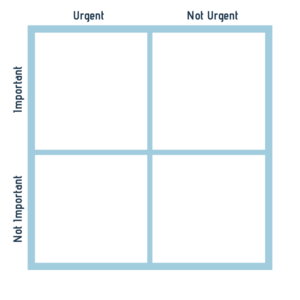5 Time Management Techniques to Get More Done

5 Time Management Techniques to Get More Done (Without More Time)
You start the workday with a cup of coffee and a to-do list that’s longer than your arm, determined to make the most of the hours you have in front of you.

When the end of the day finally rolls around, you take a look at your list to see what you managed to accomplish. You’re prepared to give yourself a well-deserved pat on the back, but instead are immediately frustrated when you realize that a large chunk of those items haven’t been touched.
What the heck happened? You haven’t left the office for the past eight hours…where did all of your time go? And why didn’t you get more done?
Sound like a familiar end-of-the-workday ritual? We get it—and we’re here to help. We’re digging into the details of why time management is such a struggle, and dishing out some techniques you can use to make time an asset, rather than your enemy.
Too Much to Do, Way Too Little Time
Do you ever feel like you’re drowning in tasks and to-dos? You aren’t alone. We’re all saddled with far too much to get done, and way too little time to do it.
According to a report from the Society of Human Resource Management, 38% of people feel overwhelmed by the amount of work they need to get done when they’re on the clock.
Additionally, a survey conducted by the Employee Assistance Program provider, ComPsych, and reported on by The American Institute of Stress, found that 46% of people cite their workload as their top workplace stressor—even above people issues, juggling their work and personal lives, and a lack of job security.
This frantic pace and constant state of overwhelm has us all feeling stressed, and this pervasive problem is taking a toll. In May of 2019, burnout was officially classified as an occupational phenomenon by the World Health Organization.
What’s the Best Time Management Technique?
We’re all spread thin—but, what can we do about it? Unfortunately, there’s no way to magically slash your to-do list in half or paste a few more hours onto your workday.
The good news is that you can manage the hours you do have way more strategically, so that you make the most of your energy, focus, and time.
So, which time management technique should you use? Well, there isn’t one right answer here. Remember, productivity is personal. That means that whatever system your deskmate swears by might not work as well for you—and vice versa.
It’s all about experimenting to find a system or tool that helps you be more efficient and effective. If you’re ready to get started, here are five common time management techniques. Which one will work best for you?
1. The Pomodoro Technique
This technique is a good fit for: People who frequently get distracted and struggle to maintain focus on their tasks.
What you’ll need:
- Your to-do list
- Timer or Pomodoro app (try Toggl’s integration!)
How it works:
You know the feeling well: you’re trying to make some major progress on that project, but you keep getting thrown off track.
You stare at the blinking text cursor for a minute before getting frustrated and clicking over to YouTube. You finally manage to get a few words down on the page before going to refill your water. You’re constantly interrupting yourself, and it’s sabotaging your ability to get meaningful work done.
This is where the Pomodoro Technique comes in handy—it breaks your workday into more manageable chunks to increase your focus.
Start by choosing the task that you want to focus on, and then set your timer or app for a block (also called a pomodoro) of 25 minutes. Work solely on that task for the entire 25 minutes, without doing anything else.
When the timer goes off? Reward yourself with a five-minute break. Then, repeat that process all over again with your next 25-minute chunk. After you complete four pomodoros, take a longer break of about 15 to 20 minutes.
This popular system gives you the ability to intensely focus on the task at hand, while still giving you the wiggle room you need to take a break and recharge every so often. Plus, you’ll undoubtedly start to challenge yourself to see just how much you can get done in those 25 minutes—you might just surprise yourself with the amount you’re able to crank through!
2. Task Batching
This technique is a good fit for: People who waste a lot of time hopping between unrelated to-dos.
What you’ll need:
- Your to-do list
- Highlighters
How it works:
Are you one of those people who brags about your superior ability to multitask? We have news for you: research proves that it’s nearly impossible for the human brain to do more than one cognitively-demanding thing at once. What you’re actually doing is rapidly switching between tasks.
That frequent changing of gears can do more damage than you might think, especially when you consider that it takes a little over 23 minutes to refocus on a task after becoming distracted.
If you’re somebody who’s prone to jumping around your to-do list without any order or strategy, task batching might be just what you need. The concept is simple: your goal is to group similar to-dos together so that you can tackle them all at once while you’re in that frame of mind.
Jot down your to-do list for the day and then take a look at the items you have listed there. For example, maybe there are emails you need to reply to, graphics you need to design, and files you need to update.
Grab your different colored highlighters and choose one color for a similar type of task. Maybe all of the emails will be in yellow while the graphics are in blue. Then, handle your tasks by those categories. Answer all of the emails in one swing, before moving on to designing all of those graphics.
It can seem a little counterintuitive, especially if you’re used to addressing items based on their urgency or the amount of energy they’ll require. But, grouping them this way will ultimately save you a lot of headaches—and time!
3. Eating the Frog
This technique is a good fit for: People who continue to push pesky tasks off until “tomorrow.”
What you’ll need:
- Your to-do list
- Courage
How it works:
Maybe you’ve heard the famous Mark Twain quote, “If it’s your job to eat a frog, it’s best to do it first thing in the morning. And if it’s your job to eat two frogs, it’s best to eat the biggest one first.”
While we’ll admit it’s an unpleasant thought (we’ll stick with cereal or eggs for breakfast, thanks), eating the frog is a concept that can do a lot of good when it comes to your time management.
Basically, it means that you should tackle your most dreaded task first. Whether it’s that monthly expense report that you consistently procrastinate on or prepping for that presentation that you’re nervously anticipating, start your day by getting it out of the way.
This offers a few benefits. First, it builds momentum. Accomplishing something—especially a task that you otherwise would’ve pushed off—right at the start of your day motivates you to keep chugging through the rest of your list.
Secondly, while it might sound strange to start the day with something you loathe, it actually sets you up for success. With your most-hated item cleared off of your to-do list, the workday can really only go up from here. Every other task seems like a breeze in comparison.
4. Golden Hours
This technique is a good fit for: People who notice significant peaks and valleys in their focus and motivation.
What you’ll need:
- Your to-do list
- Journal
- Pen or highlighter
How it works:
Maybe it’s not actually your time that you need to do a better job of managing—perhaps you need to do a better job of managing your energy.
Most people have times of day when they feel highly-focused and motivated, and other times when they’re totally checked out. Maybe you always hit a post-lunch slump that has you practically dozing off in your desk chair, but you’re a productivity powerhouse in the mornings.
One of the best things you can do is to find those times of peak productivity (often referred to as your “golden hours”) and use those to accomplish your most demanding or creative tasks.
If you’re not sure what times of day you’re at your very best, try keeping a simple journal for a week or so. Break your day into one-hour time chunks, and jot a quick note about how you’re feeling and what you accomplished during that time.
Even after just a few days, you’ll probably spot some trends that will enlighten you about your peak times of the day. When you know what those are? Protect them. Block them off on your calendar and reserve them for your most challenging to-dos, since you’ll have a much easier time dominating those when you’re able to maximize your attention and energy.
5. Eisenhower Matrix
This technique is a good fit for: People who have a lot to do, but have no idea where to start.
What you’ll need:
- Your to-do list
- Paper
- Pen
How it works:
Have you ever looked down at your seemingly never-ending to-do list and thought, “Uhh…what now?” When you have so much to do during any given day, sometimes figuring out where to start can be paralyzing.
Sure, you could just close your eyes and pick something or toss a dart at your to-do list. Or, you could use an Eisenhower Matrix to choose your starting tasks.
It’s a fancy name, but it’s surprisingly simple to implement. Grab a blank sheet of paper and divide it into four equal quadrants. Along the top, label the two columns “Urgent” and “Not Urgent.” Along the side, label the two rows “Important” and “Not Important”. You’ll end up with something that looks like this:
Now, look at your to-do list and begin dropping tasks into their designated categories. Maybe that report is both urgent and important. It should go in that corresponding box. Perhaps that project proposal is important, but not urgent. Put it there.
Separating your tasks in this way will give you a clear idea of what needs to be handled first. When you have them all assigned, follow this system:
- Urgent and Important: Tackle these first.
- Urgent and Not Important: Handle these next.
- Not Urgent and Important: Schedule time to work on these in the near future.
- Not Urgent and Not Important: These can probably fall off your to-do list entirely!
Makes sense, right? Rather than choosing tasks willy nilly, a simple matrix will bring some much-needed structure and strategy to get you started on the right things first—rather than always going after the low-hanging fruit.
Transform Yourself Into a Time Management Master
You want to make the most of the time that you have, and the above five strategies can definitely help you be more strategic and maximize your energy and your working hours.
It’s important to keep in mind, however, that even if you use these time management techniques, some days will still be better than others.
There are certain days when you’ll feel highly-focused and are able to power through your to-do list with relative ease, and there will be others when even completing one task feels an awful lot like trudging through wet cement.
Those days happen to all of us, but these strategies can still help you make the most of your good and your bad days. And when in doubt, a second (okay, third) cup of coffee doesn’t hurt either.
Source: https://toggl.com/blog/5-time-management-techniques




